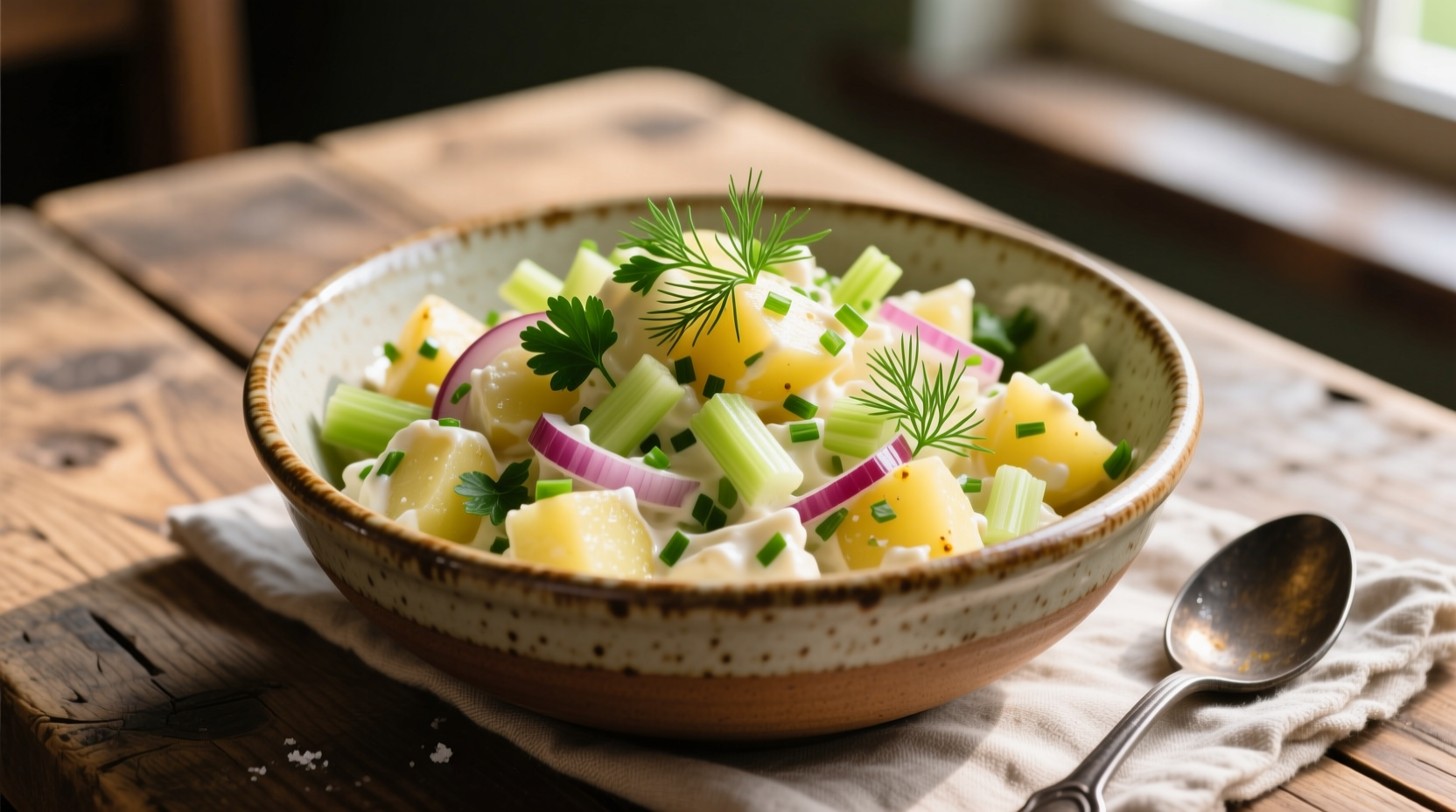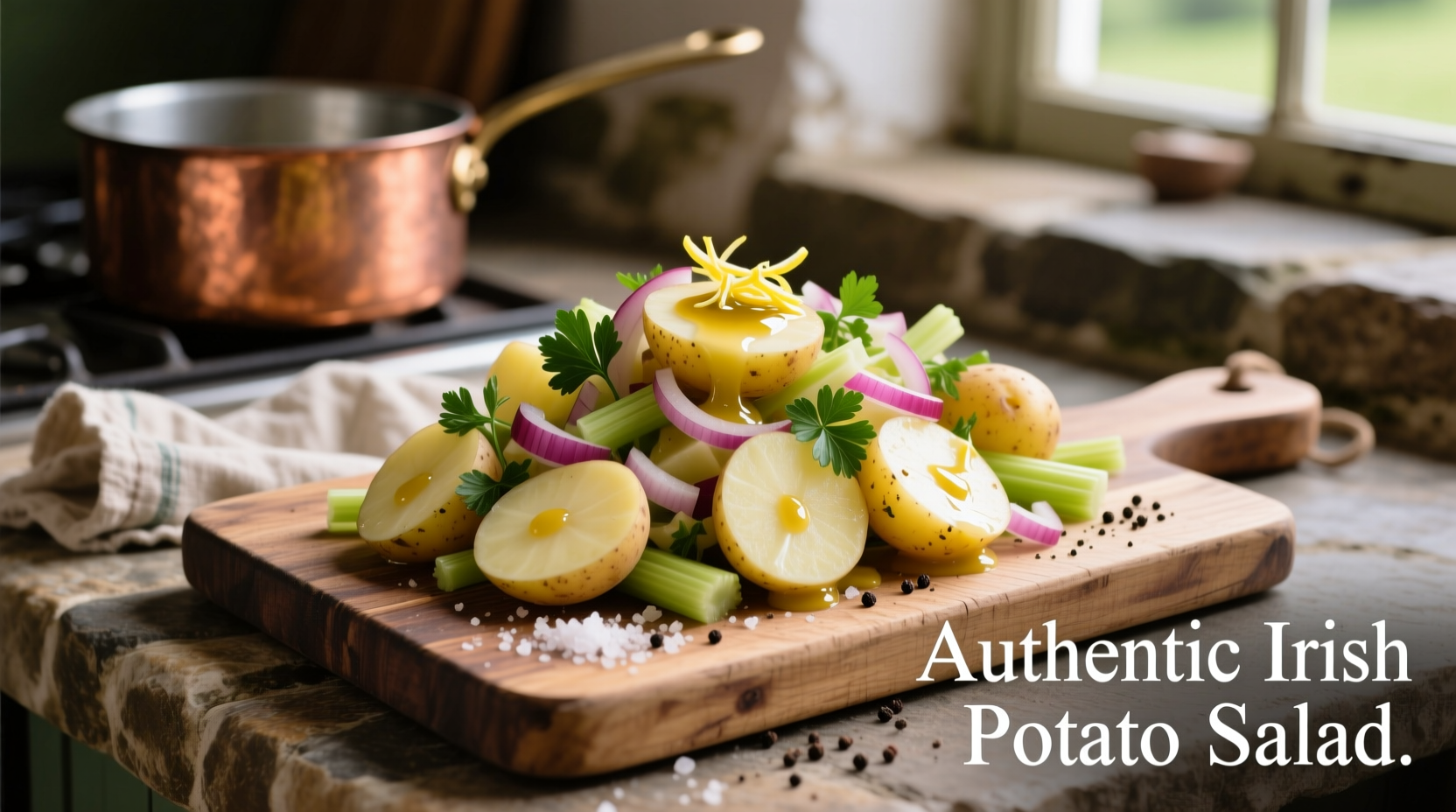Forget the mayonnaise-heavy versions you've encountered—authentic Irish potato salad centers around a tangy mustard dressing that complements Ireland's rich agricultural heritage. This humble dish emerged during the late 19th century when potatoes became Ireland's staple crop after the famine, evolving into a celebration of local ingredients rather than a creamy American adaptation.
What Makes Potato Salad "Irish"? The Essential Differences
Understanding authentic Irish potato salad requires recognizing key distinctions from its American cousin. While both use potatoes as the foundation, the Irish version maintains a lighter profile that showcases the natural flavor of locally grown spuds.
| Feature | Irish Potato Salad | American Potato Salad |
|---|---|---|
| Dressing Base | Mustard, vinegar, light cream | Mayonnaise-heavy |
| Potato Type | Floury varieties like Rooster or Kerr's Pink | Waxy potatoes like red bliss |
| Herbs | Parsley, chives, sometimes dill | Paprika, celery seed |
| Texture | Slightly chunky, rustic | Smooth, uniform |
| Serving Temperature | Room temperature | Chilled |
This comparison reflects Ireland's culinary philosophy—enhancing rather than masking ingredients. The mustard dressing originated when Irish households couldn't afford imported mayonnaise ingredients, creating a brighter flavor profile that pairs perfectly with traditional roast dinners.
Traditional Ingredients Breakdown
The authentic Irish potato salad relies on just six core ingredients, each selected for specific regional reasons:
- Potatoes: Floury varieties like Rooster (developed in County Wexford in 1962) that break down slightly when cooked, creating natural creaminess without mayo
- Onions: Sharp Irish onions (not sweet Vidalias) that provide necessary bite
- Mustard: Traditional Irish mustard made from locally grown seeds, not French or Dijon varieties
- Vinegar: Malt vinegar preferred over apple cider for its sharper profile
- Fresh Herbs: Parsley and chives from kitchen gardens
- Cream: Light cream from Irish dairy farms, never heavy mayonnaise

Step-by-Step Preparation Guide
Follow these authentic techniques passed down through Irish kitchens:
- Choose the right potatoes: Select floury varieties like Rooster, Kerr's Pink, or Irish Lumper. These potatoes have higher starch content that creates natural creaminess when slightly broken down.
- Cook potatoes properly: Boil unpeeled in salted water until just tender (15-20 minutes). The skins protect flavor and prevent waterlogging.
- Cool correctly: Drain and let sit 10 minutes before peeling—this prevents mushiness while allowing steam to escape.
- Prepare dressing: Whisk 2 tbsp Irish mustard, 1 tbsp malt vinegar, 3 tbsp light cream, 1 tsp sugar, salt, and pepper. The sugar balances Ireland's sharper mustard varieties.
- Combine ingredients: Gently fold warm potatoes with dressing, 1/4 cup finely chopped onion, and 2 tbsp fresh parsley. The warmth helps absorption.
- Rest before serving: Let sit 30 minutes at room temperature—never refrigerate, which dulls flavors and hardens potatoes.
Regional Variations Across Ireland
Irish potato salad isn't monolithic—regional differences reflect local agricultural traditions:
- Ulster (Northern Ireland): Often includes diced hard-boiled egg and a splash of Guinness for depth
- Connacht (West Ireland): Adds fresh dill from coastal gardens and uses Connemara spring water for boiling
- Munster (South Ireland): Incorporates Kerrygold butter in the dressing for extra richness
- Leinster (East Ireland): Features Dublin-grown onions and sometimes includes chopped pickles
These variations emerged from Ireland's historical regional self-sufficiency, where communities used what grew locally. The Trinity College Dublin's Irish Food History Project documents how potato preparation methods differed significantly across county boundaries before modern transportation.
When to Serve Authentic Irish Potato Salad
While commonly associated with St. Patrick's Day celebrations, traditional Irish potato salad serves specific purposes throughout the year:
- Everyday meals: Served alongside bacon and cabbage or roast lamb on Sundays
- Special occasions: Featured at weddings and christenings as a symbol of prosperity
- Seasonal pairings: Best with spring lamb (March-May) and autumn game meats (September-November)
Unlike American potato salad which often appears at summer barbecues, Irish tradition reserves this dish for cooler months when root vegetables are at their peak. The Irish Department of Agriculture's Seasonal Foods Guide confirms potatoes reach optimal flavor between September and May in Ireland's climate.
Common Mistakes to Avoid
Even experienced cooks make these errors when attempting authentic Irish potato salad:
- Using waxy potatoes: Red bliss or new potatoes won't break down properly
- Adding mayo: This immediately makes it American-style, not Irish
- Chilling before serving: Cold temperatures mute the delicate mustard flavors
- Over-mixing: Creates a mashed potato texture rather than distinct chunks
- Using dried herbs: Fresh parsley is essential for authentic flavor
Perfect Pairings for Your Irish Potato Salad
Traditional Irish meals follow specific pairing principles documented by the National Library of Ireland's culinary archives:
- Proteins: Roast lamb, boiled bacon, or smoked salmon
- Breads: Brown soda bread or potato farls
- Beverages: Dry Irish cider or a light stout like Murphy's
- Desserts: Apple tart or rhubarb crumble
The mustard dressing in authentic Irish potato salad cuts through rich meats while complementing Ireland's distinctive dairy flavors—a balance perfected over generations of farmhouse cooking.











 浙公网安备
33010002000092号
浙公网安备
33010002000092号 浙B2-20120091-4
浙B2-20120091-4